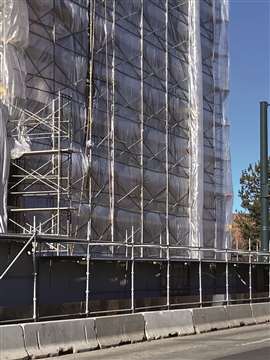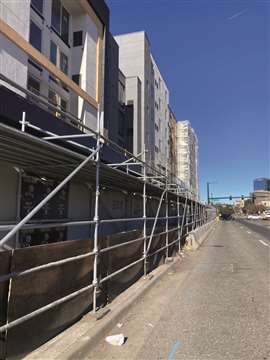Read this article in French German Portuguese Spanish
Column: Protecting workers from falling objects
23 January 2024
You probably didn’t know that on more than one occasion, a UFO has been spotted lurking around a scaffold. Or, perhaps an UAP, that is an Unidentified Anomalous Phenomenon, as the government likes to call it these days, is sneaking around your suspended scaffold. Before you get too excited about the idea that aliens are messing with scaffolds, the objects to which I refer are Unidentified Falling Objects, or UFOs. Get it, we are talking about stuff falling off scaffold platforms, as in falling object hazards. Typically they are identifiable until an accident occurs, when everyone has no idea where the object came from.
 OSHA expects workers to wear hard hats for protection. (Photo: David Glabe)
OSHA expects workers to wear hard hats for protection. (Photo: David Glabe)
While it isn’t too difficult to grasp the idea that getting hit in the head by a brick falling from four floors just might be harmful to your health, it should be equally easy to understand that not letting the brick hit you just might solve the problem. Interestingly, the approach the U.S. federal Occupational Safety & Health Administration, OSHA, takes to mitigate a falling object hazard is quite simple: “each employee shall be provided with additional protection” against falling stuff.
‘Fun’ falling facts
- Unfortunately, it appears that most people assume this means installing toeboards on all platforms. Oh, how untrue this is!
- But, just like UFOs, UAPs, or whatever, myths live concerning what really is required. So, here are some fun facts regarding falling object protection.
- Hard hats are not a form of falling object protection.
- OSHA expects you to wear a hard hat.
- The OSHA regulations address “falling hand tools, debris, and other small objects.” If you have falling objects that are too massive, you should, logically, move them away from the platform edge.
- Catching objects after they fall is harder than keeping objects from falling.
- If you are the only person left in the world, and you are on the scaffold, you do not need to install falling object protection. If such is the case, I wouldn’t worry about any aliens.
- The falling object regulations that are in the scaffold subpart of the OSHA regulations, only apply to workers on scaffolds, not to workers, or other people, including aliens, who are under and around the scaffold. To protect those people, and aliens, falling object protection as described in Subpart M of the OSHA regulations must be utilized.
- Contrary to popular opinion, falling object protection is so much more than toeboards. You can also use screens, guardrail systems, debris nets, catch platforms, barricades, and canopy structures.
- If toeboards are to be used, they must be at least 3.5 inches tall (9 cm), have a capacity of 50 pounds (222 n), have not more than a 0.25-inch (0.7 cm) gap between the bottom of the toeboard and the platform, and “securely fastened in place at the outermost edge of the platform.”
- It is common to lap scaffold planks, creating a 1.5-inch (3.9 cm) step in the platform. It is also common to use scaffold plank on edge as a toeboard. It is also common not to cut planks. It is also common to run the toeboard across the 1.5-inch (3.9 cm) step, which then creates a 1.5-inch gap between the toeboard and the platform. Oh-oh, that’s not good and that’s an OSHA violation.
- Toeboards are not part of a guardrail system. Of course, if you decide to take a nap on the scaffold platform, you may want to install a toeboard to keep you from rolling off the scaffold and becoming a falling object.
Falling object protection is much more than toeboards or canopies. (Photo: David Glabe)
- Toeboards are to be solid unless they are not. Then, the openings cannot be bigger than 1-inch (2.5 cm) in the greatest dimension. I’m not sure what that means if your falling object is smaller than 1-inch (2.5 cm) except that you should forget the exception and use a solid toeboard.
- You’ll like this one: If the toeboard won’t keep the stuff piled higher than the toeboard from falling off, erect “paneling or screening extending from the toeboard or platform to the top of the guardrail for a distance sufficient to protect employees below.” Really? That has to be stated? Alternatively, “a guardrail system shall be installed with openings small enough to prevent passage of potential falling objects.”
- OSHA requires that if the “falling objects are too large, heavy, or massive to be contained or deflected by any of the above listed measures, the employer shall place such potential falling objects away from the edge of the surface from which they could fall and shall secure those materials as necessary to prevent their falling.” (If you are one to carefully follow the precise reading of a regulation, this means that you should not move the object, but you should get your boss out on the scaffold to move it. Let me know how that works out for you.)
- If you are to use a canopy structure, debris net, or catch platform, not only shall it be strong enough to withstand impact forces, but it shall also be erected over the employees below. (I hope nobody would install it under the employees below.)
- Here’s a good one: If canopies are used, make sure you install them between the falling object hazard and the employees. Think about that one.
- If you decide to utilize a catch platform to catch stuff, install it as close to the point where the stuff will start falling, to reduce the force of impact.
- OSHA refers the reader to non-mandatory Appendix A of the regulations for guidance on the construction of a compliant toeboard. It lists a 1-inch (2.5 cm) tube and 1.25-inch (3.1 cm) by 1.25-inch (3.1 cm) steel angle as options. I’m not sure how you would meet the minimum 3.5-inch (9 cm) height requirement with either the tube or the angle. Flattening the tube doesn’t get you to 3.5 inches. I tried it.
 Falling object protection is described in OSHA’s Subpart M portion of regulations. (Photo: David Glabe)
Falling object protection is described in OSHA’s Subpart M portion of regulations. (Photo: David Glabe)
- A catch platform constructed of plywood and scaffold plank, while it looks good, probably won’t safely stop a 125 pound (57 kg) concrete masonry unit falling from 20 feet, unless it breaks up on impact.
- Barricades can be used for falling object protection. Since the OSHA regulations are not instructions, no guidance is provided as to where to locate the barricade, that is the distance it should be placed away from the scaffold. One solution is to hire a qualified engineer to ascertain the projectile distance based on the weight and initial velocity of the falling projectile. A more economical solution would be to kick the object off the highest platform, see where it lands, add a few feet for safety, and install the barricade at that location.
- There are no height specifications for barricades, but it is reasonable to construct them to meet the guardrail height requirements.
- Falling objects, such as a wrench, like to bounce around and off various scaffold components on their trip to the ground. This means that an object dropped at one location won’t necessarily fall straight down to the ground. Like aliens, it might show up at the most unanticipated location.
- By now you might be wondering what the difference is between the OSHA Subpart L and Subpart M falling object regulations. It’s worth the exercise to look them up and do the comparison. You’ll find them at 29 CFR 1926.451(h) for scaffolding and 29 CFR 1926.502(j) for walking/working surfaces.
While the tone of this article may lack some seriousness, falling object protection is a serious matter, aliens notwithstanding. Don’t take a chance; any falling object can result in debilitating injury and death. Common sense should tell you that caution is the best approach.
STAY CONNECTED



Receive the information you need when you need it through our world-leading magazines, newsletters and daily briefings.
CONNECT WITH THE TEAM





